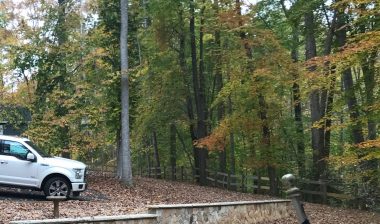Even After My Lung Transplant, Fall Continues to Taunt Me
The season's airborne particles can pose a threat to PF and transplant patients
Written by |

A change in seasons is underway here in Virginia, and across the mid-Atlantic. Trees that were once lush and green are now exploding with fiery red, burnt orange, and golden hues. All of those leaves have also begun to fall from the trees to the ground. Firewood is stacked and kindling is gathered as winter approaches.
Fall is one of my favorite seasons, but in my post-transplant world, it taunts me.
It’s not you, it’s me
I was diagnosed with idiopathic pulmonary fibrosis (IPF) in January 2017. At the time, my wife, Susan, and I were planning to retire to our home in Lake Anna, Virginia, where I was keeping up some outdoor maintenance tasks.
We started living here full time after I stopped working and went on disability in September of that year. By then, the list of outdoor tasks I was able to complete was even shorter due to IPF. Initially, I was able to run the backpack leaf blower to clear the driveway, but before long, that became a task for Susan. My shortness of breath came on more quickly.
I started a small vegetable garden on the side of our home, but my care team quickly overruled me on working in the soil. I was fine with that guidance, as it seemed my green thumb was in remission. Even the deer didn’t eat what I was growing.
My seasonal allergies, combined with the challenges of IPF, became more rigorous to manage. My care team took a proactive approach by having me use Zyrtec (cetirizine), Flonase (fluticasone), and Mucinex (guaifenesin), which can all relieve allergy symptoms, more regularly, and sometimes daily.

Fall taunts me at Lake Anna, in Virginia. (Photo by Sam Kirton)
So, what’s the problem?
My pulmonary fibrosis was idiopathic, meaning the cause was unknown. However, one identifiable cause of PF is environmental exposure to toxic substances like asbestos and coal dust. Some researchers think that exposure to other airborne particles, such as soot, dust, pollen, and ash, could also be a risk factor for PF. One report about a cluster of IPF cases among dentists even raised the question of whether occupational exposures to certain substances contribute to the illness.
Another example is the incidence of PF among World Trade Center (WTC) first responders. A study published in 2019 in the International Journal of Environmental Research and Public Health found “evidence of the association between WTC dust and PF risk among WTC responders, adding evidence to the literature of occupational exposure and self-reported PF.” Former New York City police detective Tom Frey was one of the first responders who developed PF as a result of his work on 9/11.
Working in my yard, my exposure is mostly limited to less harmful particles like dust and pollen. Nevertheless, these can still pose issues for me.
Exposure post-transplant
I received a bilateral lung transplant on July 10, 2021. Following my discharge on July 20, Susan and I spent three months in an apartment close to the hospital. Those days were filled with follow-up appointments with my care team and three weekly pulmonary rehabilitation sessions.
When we returned home to Lake Anna in October, fall was already upon us. I felt great. My oxygen saturation, when not at 100%, was in the high 90s. Thanks to pulmonary rehabilitation, shortness of breath was no longer as big of an issue.
I was anxious to exercise my new lungs, so I put on the backpack leaf blower and proceeded to clear the yard. Susan recognized the look of victory on my face. The look was short-lived.
At that point in my recovery, I had regular clinic visits. During my next one, I was proud to let my care team know that operating the leaf blower didn’t cause any shortness of breath or drops in oxygen saturation. I suspected something was wrong when I saw their faces. They didn’t want me to do that again.
Even wearing a mask, the airborne particles stirred up by the leaf blower presented a serious threat to my new lungs. Short of directly aspirating dry leaves, this was a risk I didn’t need to take. I promised my care team that my leaf-blowing days were over.
Protecting my gift
I considered a variety of ideas for annual leaf removal. My favorite was to offer a leaf removal certification, which consisted of a 15-minute tutorial followed by a two-hour practicum. Registration for the free course would be on a first-come, first-serve basis. The course would be offered weekly, depending on the availability of sufficient leaves to teach the techniques. No prerequisites would be required. Unfortunately, it wasn’t really a viable plan.
Susan and I are finding other ways to deal with the leaves. It’s more important to protect my donor’s gift. These lungs will allow me to make every breath count.
Note: Pulmonary Fibrosis News is strictly a news and information website about the disease. It does not provide medical advice, diagnosis, or treatment. This content is not intended to be a substitute for professional medical advice, diagnosis, or treatment. Always seek the advice of your physician or other qualified health provider with any questions you may have regarding a medical condition. Never disregard professional medical advice or delay in seeking it because of something you have read on this website. The opinions expressed in this column are not those of Pulmonary Fibrosis News or its parent company, Bionews, and are intended to spark discussion about issues pertaining to pulmonary fibrosis.








Catherine Leonard
Dear Sam,
Just a short note to let you know I’ve read and appreciate your column. Not sure that I will ever be a transplant candidate as cancer has a way of negating that option, but thank you! One of my pleasures as a non-farmer, casual gardener was to dig into dirt and play in our small yard. Of all the things I’ve been denied, the instructions to avoid further plant tending has felt most cruel. After all, it wasn’t as lofty as skiiing or mountain hiking!
Catherine
Samuel Kirton
Hi Catherine
Thanks for reading my column and for your note. I am sorry to learn that you are also dealing with cancer. Without knowing specifics of your cancer experience, I can say that I am aware of people who have beat cancer and were considered for a transplant. Have you discussed with your care team what might be acceptable? What if you did not use soil but grew a hydroponic garden? Perhaps they can be creative with you to look for a solution. Sam ...